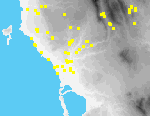 M04 Gargaliani Ayios Konstadtinos
M04 Gargaliani Ayios Konstadtinos
The church of Ayios Konstadtinos and Eleni[098.05][114.33] is located ca. 2.1 km. S of the outskirts of Gargaliani, on a knoll in a ridge[091.09] that overlooks the plateau between Gargaliani and Lefki from the S[091.12]. There is a well ca. 200 m. to the E of the church. S and SW of the knoll are terraces planted with olives; to the N is a steep, maquis-covered slope. At its W end, the knoll is connected by a saddle to a higher part of the ridge.
The church was completely rebuilt between the summers of 1994 and 1995, when an older structure with the same dedication was largely demolished. In 1994 when the site was first visited by members of PRAP, it was noticed that large blocks, possibly ancient, were built into the old church.
In 1995 artifacts were found in the flat bulldozed clearing around the church.[098.01] Construction of the new church has disturbed the area greatly; the yard, surrounded on all sides by maquis, is littered with debris from the former church, building materials, modern garbage, and chunks of bedrock.
Two large ashlar limestone blocks[114.29] (1.45 m. L. x 0.75 m. W. x 0.45 m. H.; 0.96 m. L. x 0.47 m. H. x 0.7 m. max. pres. W.) lie ca. 10 m. N of the new church; they are probably among those seen in the old church in 1994. There are two other limestone blocks (0.57 m. W. x 0.4 m. H.; 0.7 m. L. x 0.42 m. max. pres. W., with a cutting in it, ca. 0.36 m. x 0.25 m.) in the spoil tip on the N slope of the knoll and a third of equivalent size on the E side of the church.
Most ancient pottery was found near the E end of the church; three fragments of possibly a human bone were found N of the church.
Ayios Konstantinos produced a very small quantity of ceramic material. The sherds were quite small, but not abraded, with good surface preservation. The diagnostic material ranges from Late Classical to Modern. A knoll adjacent to the main study area also produced a possibly Hellenistic?? pithos.